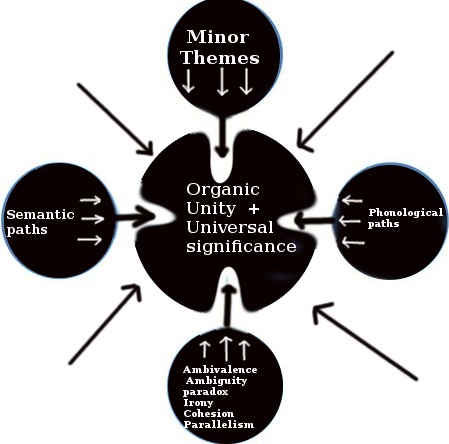
Just like eating bread with tea criticism helps readership. It also lends power to the pert of the author’s pen.
The text (in this case the poem) must fine tune with the theory of the critical approach Hence poem analysis like the one below also goes a long way in promoting criticism or poem analysis.
Presenting the theory of New Criticism or close reading with visual aid I will directly make a dive into dissecting the poem The Wind and Children by the famous Lithuanian poet Salomeja Neris. New Criticism focuses on the text and text alone.
That is why it is also referred to close criticism. “Close reading is a method of literary analysis which focuses on the specific details of a passage or text in order to discern some deeper meaning present in it.
The meaning derived from the close reading is the reader’s interpretation of the passage or text,” Close-Reading.pdf (bucks.edu) The wind and children BY Salomeja Neris The harbingers of happy days, Long icicles are seen The wind comes beating our wall As if in a tambourine.
Loud laughs the wind, for well it knows Soon orchards green will be Into the windows, doors it gets: “Blackbirds are coming, see!” “Hey, children!” to small folk he will cry, “Come out fair spring to meet. I’ll make the meadows dry for youTo patter with bare feet.” Spring, spring! How fine it is, how blue! Blow, wind, still gayer blow! We’ll open windows wide for youYou love small folk, we know.
The imagery ‘long icicles’ (on the second line of the first stanza) shows the melting of an iceberg as a public symbol to the forthcoming pleasant season that ensures the revival of everybody’s mood.
By the magic of word pictures, rhythmic language the persona as a unifying theme leads us to experience a resurrection of hope and a desire for felicitation that comes in tandem with the backpedaling of an inclement weather, depicting the poem is of a universal significance.
When a disagreeable and gloomy season, with a dreary and stifling weather wraps up and its termination heralds the ushering in of a new lease of life, all and sundry will be overtaken by an effable and all engulfing glee .The point of view we used in the poem twice on the last line and immediately above the last, shows the blissful occasion is for all.
The landscape, the flora and fauna inclusive, prides itself with natural beauty. Imbued with an enviable freedom children, whom the wind befriend best as clearly put in the third stanza, mad with ecstasy, run all over the neighborhood with bare feet, tapering the fields, no more engulfed and bedraggled by a snow.
The wind personified in the poem (3rd line first stanza and 1st line 2rd stanza) no longer laden with snow but fresh air, generating a melodious music against roofs and windows, reinforcing the central theme, tempts people to thaw the all-enveloping and debilitating depressing mood and come outdoors. Here it is important to see the denotative meaning of spring.
It as well could mean to release or be released from a forced position. The simile ‘like a tambourine’ on the last line of the first stanza displays a brilliant picturesque simile between a musical instrument, which creates a mellifluous music when drubbed with a palm and a pleasurable wind drubbing doors and windows.
The personal metaphor ‘loud laughs the wind’ on the first line of the second stanza, also signifies the upcoming merry time and its joviality. Spring, a season of rebirth and profusion, is a public symbol that signifies the drawing nigh of happy days.
The recurrence of the emphatic words blow (a trumpet probably) and the word spring in the last stanza augments the underlying theme, a time to felicitate. The images ‘orchards green’ second line second stanza and ‘blue’ last line of last stanza also signify a time for blooming, agreeable sky and hence felicity.
Birds of every brand fettered to their cadges for months on end also run Amuck, for they know spring is gracious.(Black birds are coming see, last line 2nd stanza) The exclamation mark or figure of construction See! at the end of this line is not put without a reason, it is a public knowledge blackbirds shun stifling weather and their return, a delightful surprise, augurs the retreat of the disagreeable one.
Observes are also welcoming the wind as a cherished guest with outspread hands, We’ll open windows wide for you, is an embodiment of a brilliant personification that adds a brick to the central theme. By the skillful choice of diction, play with syntax such as inversion and carefully waving the sounds into pattern, the word painter magnifies the melody of the poem. And the poet puts stress on certain words by deviating them from the normal or prosaic grammar rule.
See the following excerpts: orchards green will be (the orchards will be green) loud laughs the wind (the wind laughs loud) to doors it gets (it gets to doors) fair spring to meet (to meet fair spring) Apart creating paths towards the central theme, the rhyming words also prove pleasing to the experienced ear (see, be; harbingers, days, icicles, laughs, knows, orchards, windows, doors, gets, knows; dry, cry; blow, know; out, meet, feet; seen, tambourine, green )The tone of elation in the figures of construction (How blue! , Gayer blow! and we know! ) rife at the closing lines gives impetus to the unifying theme, a celebration is called for. See also the epistle fair attached to spring is in the same wavelength. Using an opposition of imagery between a flouted season and a happier one, indirectly mentioned, the persona tries to relate a tension that further accentuates the central theme the ousting of a stifling weather by a friendly one.
What the poem says and how it says it is one and the same. The formal elements skillfully deployed in the poem call to mind the intensity of the tension between the flouted disagreeable season and the most sought-for one that gives room for jubilation.
They as well celebrate spring depicting organic unity of form and content. The word images, through similarity of meaning, that streamline the surge of the somewhat disarrayed paths of connection towards the organic unity or poetic web are: happy days, harbinger, icicles, tambourine, loud laughs, orchards green, come see! , meadows dry patter, bare feet, spring, fine, blue, and gayer and love. From the tone of the persona, put in first person plural, we detect a happy tone and a playful attitude.
In spring children could patter the meadows with bare feet liberated from the aversion to a freezing cold. The binary opposition is between a stifling and fascinating weather.
BY ALEM HAILU G/KRISTOS
The Ethiopian Herald 16 February 2022




